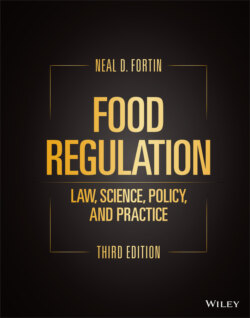Читать книгу Food Regulation - Neal D. Fortin - Страница 103
3.3.3 The Internet and Labeling
Оглавление* * * * *
FDA Letter on Labeling Food Products Presented or Available on the Internet
U.S. Food and Drug Administration
Center for Food Safety and Applied Nutrition
November 1, 2001
[To: Washington Legal Foundation]
…
This letter responds to your citizen petition… . Your petition asked FDA to “formally adopt a rule, policy, or guidance stating that information presented or available on a company’s Internet website, including hyperlinks to other third party sites, does not constitute ‘labeling,’” as defined by the Federal Food, Drug, and Cosmetic Act (FD&C Act) at 21 U.S.C. § 321(m). In your petition, you further requested that the rule, policy, or guidance specify that such information may, but does not necessarily, constitute advertising. Alternatively, you asked FDA to adopt a rule, policy, or guidance “exempting Internet information of food companies from labeling requirements.”
… FDA, however, disagrees that information presented or available on a company’s website could never constitute labeling. “Labeling” is defined in section 201(m) of the FD&C Act (21 U.S.C. § 321(m)) as “all labels and other written, printed or graphic matter upon any article … or accompanying such article.” In Kordel v. United States, 335 U.S. 345 (1948), the Supreme Court concluded that the phrase “accompanying such article” included literature that was shipped separately and at different times from the drugs with which they were associated. “One article or thing is accompanied by another when it supplements or explains it, in the manner that a committee report of the Congress accompanies a bill. No physical attachment one to the other is necessary. It is the textual relationship that is significant.” Id. at 350. The Court also noted that the literature and drugs were parts of an integrated distribution program.
Based on this authority, FDA and the courts have interpreted “labeling” to include “[b] rochures, booklets, … motion picture films, film strips, … sound recordings, … and similar pieces of printed, audio, or visual matter descriptive of a drug … which are disseminated by or on behalf of its manufacturer, packer, or distributor… .”…
Lower court cases after Kordel reinforce a broad reading of the term “accompanying.”… In addition, the courts have considered whether the information and the product are part of an integrated distribution program, where, for example, the information and the product originate from the same source or the information is designed to promote the distribution and sale of the product, even if such sale is not immediate….
Accordingly, FDA believes that, in certain circumstances, information about FDA‐regulated products that is disseminated over the Internet by, or on behalf of, a regulated company can meet the definition of labeling in section 201(m) of the FD&C Act. [Emphasis added.] For example, if a company were to promote a regulated product on its website, and allow consumers to purchase the product directly from the website, the website is likely to be “labeling.” The website, in that case, would be written, printed, or graphic matter that supplements or explains the product and is designed for use in the distribution and sale of the product.
To provide an example from the other end of the spectrum, some product‐specific promotion presented on non‐company websites that is very much similar, if not identical, to messages the agency has traditionally regulated as advertisements in print media (e.g., advertisements published in journals, magazines, periodicals, and newspapers) would be viewed as advertising. These are just examples at the extremes and, as discussed below, the agency will proceed on case‐by‐case basis in determining what is “labeling.” …
FDA has explored developing a guidance on promotion of FDA‐regulated products on the Internet, but has decided not to issue a document at this time. The agency believes that any rule or guidance on this issue would be quickly outdated due to the ongoing rapid changes in the Internet and its use. As a result, issuing a rule or guidance may stifle innovation and create greater confusion among industry and the public. For the time being, FDA will continue to use a case‐by‐case approach based on the specific facts of each case….
FDA appreciates your interest in this area.
Sincerely yours,
Margaret M. Dotzel
Associate Commissioner for Policy
* * * * *
